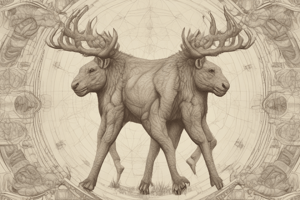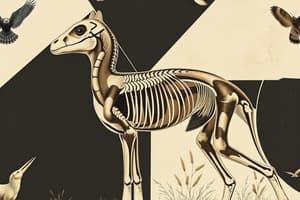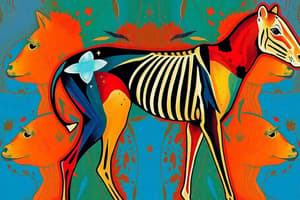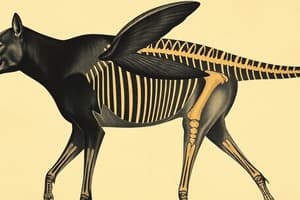Podcast
Questions and Answers
What is the primary method of nutrition for Phylum Porifera?
What is the primary method of nutrition for Phylum Porifera?
- Filter feeding (correct)
- Parasitism
- Photosynthesis
- Predation on small fish
Which phylum includes organisms with specialized stinging cells?
Which phylum includes organisms with specialized stinging cells?
- Phylum Cnidaria (correct)
- Phylum Annelida
- Phylum Rotifera
- Phylum Platyhelminthes
Which of the following best describes the digestive system of flatworms?
Which of the following best describes the digestive system of flatworms?
- Complete with two openings
- Incomplete with a single opening (correct)
- Gastrovascular cavity without openings
- None of the above
What unique feature do mollusks possess that aids in locomotion?
What unique feature do mollusks possess that aids in locomotion?
Which class of mollusks includes animals with two hinged shells?
Which class of mollusks includes animals with two hinged shells?
What distinguishes cephalopods from echinoderms in terms of movement and defense mechanisms?
What distinguishes cephalopods from echinoderms in terms of movement and defense mechanisms?
Which feature of arthropods contributes to their ability to adapt to various environments?
Which feature of arthropods contributes to their ability to adapt to various environments?
How do animals communicate effectively according to the information presented?
How do animals communicate effectively according to the information presented?
What is the first step in the sexual reproduction process in multicellular animals?
What is the first step in the sexual reproduction process in multicellular animals?
In the context of the male reproductive system, which structures are classified as external organs?
In the context of the male reproductive system, which structures are classified as external organs?
What type of symmetry describes animals whose halves look the same regardless of how they are split?
What type of symmetry describes animals whose halves look the same regardless of how they are split?
Which of the following statements accurately defines protostomes?
Which of the following statements accurately defines protostomes?
Which characteristic is used to distinguish vertebrates from invertebrates?
Which characteristic is used to distinguish vertebrates from invertebrates?
What defines eumetazoans in the animal kingdom?
What defines eumetazoans in the animal kingdom?
Which type of body cavity is completely lined with tissue?
Which type of body cavity is completely lined with tissue?
What role do the testicles play in the male reproductive system?
What role do the testicles play in the male reproductive system?
What is the purpose of the cremasteric reflex in the testicles?
What is the purpose of the cremasteric reflex in the testicles?
Which structure is primarily responsible for the reception of the ovulated egg in the female reproductive system?
Which structure is primarily responsible for the reception of the ovulated egg in the female reproductive system?
What is the primary function of the uterine lining during the menstrual cycle?
What is the primary function of the uterine lining during the menstrual cycle?
Which of the following accurately describes a function of the circulatory system?
Which of the following accurately describes a function of the circulatory system?
Which chamber of the heart receives deoxygenated blood from the body?
Which chamber of the heart receives deoxygenated blood from the body?
What could be a consequence of plaque buildup in coronary arteries?
What could be a consequence of plaque buildup in coronary arteries?
What is the role of the pulmonary circuit in the circulatory system?
What is the role of the pulmonary circuit in the circulatory system?
What happens to the uterine lining if fertilization and implantation do not occur?
What happens to the uterine lining if fertilization and implantation do not occur?
Which blood vessel transports oxygenated blood from the lungs back to the heart?
Which blood vessel transports oxygenated blood from the lungs back to the heart?
Flashcards are hidden until you start studying
Study Notes
Animal Body Plans
- Features and organization of animal body plans aid in classification and evolutionary studies.
- Body symmetry is a key differentiator:
- Radial symmetry allows for equal halves regardless of division.
- Bilateral symmetry results in symmetrical halves mirroring each other, seen in mammals, including humans.
- Asymmetry is rare, characterized by a lack of symmetry.
- Structural differentiation includes body cavities (coelom vs pseudocoelom) and the location of body structures: anterior (head), posterior (tail), dorsal (top), and ventral (bottom).
- Eumetazoans possess true tissues, while protostomes and deuterostomes are classified based on embryological development of mouth and anus.
Classification of Animals
- Kingdom Animalia comprises multicellular heterotrophs without cell walls.
- Animals are categorized into vertebrates (with backbones) and invertebrates (without backbones).
- Vertebrate classification includes five main types: fish, amphibians, reptiles, birds, mammals, all in Phylum Chordata.
- Over 90% of animal species are invertebrates, spread across more than 30 phyla and 1.3 million species.
Major Invertebrate Phyla
- Phylum Porifera: Sponges, immobile filter feeders.
- Phylum Cnidaria: Jellyfish, corals, and sea anemones with specialized stinging cells; over 10,000 species exist.
- Phylum Platyhelminthes: Flatworms, capable of regeneration; a tapeworm is a common example.
- Phylum Nematoda: Roundworms; many are parasitic, infecting hosts including humans.
- Phylum Arthropoda: Characterized by segmented bodies and an exoskeleton made of chitin; includes arachnids, crustaceans, and insects.
- Phylum Echinodermata: Marine animals with spiny skins, such as sea stars and sea cucumbers; exhibit pentaradial symmetry in adulthood.
Worm Types
- Types of worms include flatworms, roundworms, and segmented worms.
- Parasitic worms, known as helminths, affect hosts negatively.
- Hookworms and Ascaris are common parasitic infections in humans.
Mollusks Overview
- Invertebrates known for soft bodies, belonging to Phylum Mollusca.
- Common classes include:
- Gastropoda: Snails and slugs, some with shells.
- Bivalvia: Clams and oysters, filter feeders with two hinged shells.
- Cephalopoda: Squids and octopi, known for advanced eyes and ink production.
Echinoderms
- Divided into five classes: Asteroidea (sea stars), Echinoidea (sea urchins), Crinoidea (sea lilies), and more.
- Possess a calcium carbonate endoskeleton and a water vascular system aiding in movement and feeding.
- Can reproduce sexually and regenerate parts.
Arthropods
- Largest group of invertebrates with segmented bodies and an exoskeleton.
- Comprised of five major groups: Chelicerates, Myriapods, Crustaceans, Hexapoda (insects).
- Part of their success is attributed to their flexible exoskeleton and diverse adaptations.
Biological Clocks
- Internal biological clocks regulate daily rhythms in living organisms, known as circadian rhythms.
- Located in the hypothalamus for mammals; rely on environmental cues but maintain a set schedule independently.
Communication in Animals
- Effective communication relies on clear signals which can be visual, auditory, chemical, or electrical.
- Different signals serve specific purposes based on environmental context and species involved.
Sexual Reproduction in Animals
- Involves gametogenesis to produce sperm and ova.
- Fertilization leads to the formation of a zygote, which undergoes cleavage and germ layer development (ectoderm, mesoderm, endoderm).
Male Reproductive System
- Consists of external structures (penis, scrotum) and internal organs (testicles, epididymis, vas deferens).
- Testicles produce sperm and testosterone, regulated by temperature and reflex mechanisms.
Female Reproductive System
- Composed mainly of internal structures including ovaries, fallopian tubes, uterus, cervix, and vagina.
- Functions include gamete production, fertilization, and menstrual cycles; the uterine lining prepares for potential embryo implantation.
Circulatory System
- Comprises heart, blood, and vessels; consists of pulmonary (lungs) and systemic (body) circuits.
- Essential for nutrient transport, waste removal, immune response, and homeostasis.
Heart Anatomy
- Four chambers: right atrium, right ventricle, left atrium, left ventricle, separated by valves.
- Blood flow: from the body to the right atrium, to the lungs, back to the left atrium, and pumped to the body.
Heart Health
- Atherosclerosis causes plaque buildup, impacting blood flow and potentially leading to coronary heart disease.
- Poor heart function can result in angina or heart attacks, with chronic conditions leading to congestive heart failure.### Cardiovascular System
- Left heart failure results in blood backing up into the lungs, causing breathing difficulties.
- Right heart failure leads to blood pooling in the body, particularly in lower extremities, resulting in edema.
- The lymphatic system supports the cardiovascular system, vital for drainage of interstitial fluid which becomes lymph.
Lymphatic System
- Comprises lymph, lymphatic vessels, lymph nodes, and lymphatic capillaries.
- Transports chyle (lymph from the small intestine) through lacteals.
- Lymph movement aided by breathing and muscle contractions, crucial for immune system function by filtering harmful microbes.
Red Blood Cells
- Red blood cells (RBCs) are disc-shaped, anucleated, and constitute 40-45% of blood volume.
- Primary function: transport oxygen (via hemoglobin) and carbon dioxide.
- Produced in red bone marrow from stem cells (hemocytoblasts) that mature into RBCs over a period of about 120 days.
Blood Types and Transfusions
- The ABO blood group system categorizes blood based on the presence of A and B antigens on RBCs.
- Type A has A antigens and produces anti-B antibodies; Type B has B antigens and produces anti-A antibodies; Type AB has both antigens with no antibodies; Type O has no antigens but produces both antibodies.
- Type AB is a universal recipient; Type O is a universal donor.
- Wrong transfusions can cause agglutination, obstructing blood circulation.
Blood Vessel Structure
- Blood travels from the heart through arteries to arterioles, then to capillaries where gas and nutrient exchange occurs.
- Deoxygenated blood moves from capillaries into venules, then veins, and back to the heart via vena cava.
- Veins contain one-way valves to prevent backflow, assisting venous return aided by skeletal muscle contraction.
Heart and Blood Circulation
- Blood is propelled to the lungs by the right ventricle through the pulmonary artery for oxygenation.
- Oxygenated blood returns to the left atrium via pulmonary veins, then is pumped into the aorta, the largest artery.
Aorta and Major Arteries
- The aorta branches supply blood to essential body parts including head, neck, arms, and the lower body.
- The celiac trunk supplies digestive and urinary organs; common iliac arteries supply legs.
Vena Cava and Coronary Circulation
- Superior and inferior vena cava return deoxygenated blood to the right atrium.
- The coronary system supplies oxygenated blood to the heart muscle itself.
Urinary System
- Made up of kidneys, ureters, urinary bladder, and urethra, responsible for urine production and toxin removal.
- Conditions affecting the urinary system include infections and kidney stones.
Digestive System
- The mouth initiates mechanical and chemical digestion, mixing food with saliva produced by salivary glands.
- Saliva contains enzymes that begin starch digestion and is crucial for taste perception.
Endocrine System
- Comprised of glands that secrete hormones influencing growth, metabolism, and homeostasis.
- Hormones function through specific receptors and include insulin and sex hormones.
- Hypothalamus and pituitary glands regulate hormone release in the body.
Thyroid Gland
- Produces hormones that regulate metabolism; iodine is essential for hormone synthesis.
- Conditions include hypothyroidism (underactive), hyperthyroidism (overactive), and goiter (iodine deficiency).
Diabetes Mellitus
- Caused by insufficient insulin production or resistance, leading to high blood sugar and symptoms like increased thirst and urination.
- Types include Type 1 (insulin deficiency), Type 2 (insulin resistance), and gestational diabetes during pregnancy.
Skeletal Muscle
- Voluntary muscles attached to bones, made of bundles of muscle fibers containing myofibrils (actin and myosin).
- Functions include movement, support, and thermoregulation; issues can arise such as cramping or muscular dystrophy.
Connective Tissue
- Provides support and structure; includes fibrous connective tissues like ligaments and tendons.
- The Achilles tendon is the largest tendon, while tendonitis refers to inflammation of the tendons.
Studying That Suits You
Use AI to generate personalized quizzes and flashcards to suit your learning preferences.




